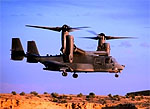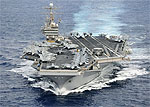May 20, 2013 Military Aviation News

05/20/2013
Two systems. One, the S-300, is an advanced version of the air-defense system originally designed in the Soviet Union in the 1970s and further developed in the 1990s. The S-300 has several advantages over the older Soviet-era anti-air batteries Syria already uses. First, the range of its radar and missiles allows it to hit targets at ranges of up to 200 kilometers.
(Read More...)

05/20/2013
Almost four years after the MV-22 Osprey arrived in Afghanistan, trailing its reputation as being dangerous and hard to maintain, the U.S. Marine Corps finally has had an opportunity to test the controversial hybrid aircraft in real war conditions. The reviews are startlingly positive. “This is an ugly duckling that turned into a swan,” said Richard Whittle, the author of a book about the craft and a senior scholar at the Wilson Center, a research center in Washington.
(Read More...)

05/20/2013
Hamid Karzai has let the Pentagon’s cat out of the bag — to the displeasure of the Obama Administration. The Afghan president revealed inside information about President Obama’s war plans after all U.S. “combat troops” completely withdraw in 17 months at the end of 2014.
(Read More...)

05/20/2013
The U.S. Navy’s first Unmanned Combat Air System Demonstrator (UCAS-D) designed to fly from the flight deck of an aircraft carrier entered the public consciousness in June, 2012 as a UFO sighting as it traveled from Edwards AFB to Naval Air Station Patuxent River. Not quite a year later and within 72 hours time, the UCAS-D provided a glimpse of what the future might be for Naval Aviation.
(Read More...)

05/20/2013
This March 10, 2010 photo released by the U.S. Navy shows Afghan commandos practicing a quick disembark from and MI-17 transport helicopter during static drills prior to an air assault into the outer regions of Kabul, Afghanistan. The air assault was the second mission coordinated through the Afghan National Air Corps with the commandos, but the first combined assault with the American CH-47 Chinook helicopter. Photo: MC2 David Quillen, U.S. Navy.
(Read More...)

05/20/2013
Air Force Lt. Col. Peter Garretson is the Division Chief for Air Force Irregular Warfare Strategy, Plans and Policy (and previously the Chief of Future Science and Technology Exploration for Air Force Strategic Planning). Recently he published a paper titled A Range-Balanced Force, An Alternate Force Structure Adapted to New Defense Priorities. The topic on hand was, you guessed it, RPAs and UAVs.
(Read More...)
All Articles